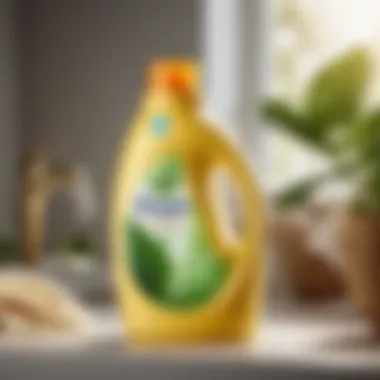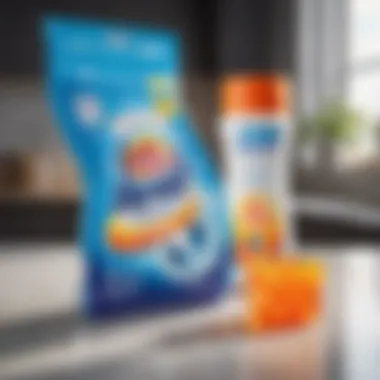Revolutionary Techniques for Fabric Softener-Free Laundry Detergents


Materials
- 1 cup of baking soda
- 1 cup of washing soda
- 1/2 cup of citric acid
- 1 bar of castile soap
- Essential oils of your choice (optional)
DIY Steps
- Grate the bar of castile soap into fine shavings.
- In a mixing bowl, combine the grated soap, baking soda, washing soda, and citric acid.
- If desired, add a few drops of essential oils for fragrance.
- Thoroughly mix all the ingredients until well combined.
- Transfer the mixture into an airtight container for storage.
Technical Aspects
- Tools: Cheese grater, mixing bowl, measuring cups
- Timing: Approximately 15 minutes
- Critical Techniques: Ensure thorough mixing to evenly distribute ingredients
DIY Project Process
- Use 1-2 tablespoons of the detergent mixture for each laundry load.
- Add the detergent directly to the drum before adding clothes.
- Wash laundry as usual.
Troubleshooting Tips
- If the detergent clumps, break up clumps before use.
- Adjust the amount of detergent based on load size and water hardness.
Introduction
In the realm of laundry care, the choice of detergent plays a significant role in achieving clean and soft fabrics. The absence of fabric softeners in laundry detergents opens up a new avenue of exploration for consumers seeking effective yet fabric-friendly cleaning solutions. This article delves into the innovative approaches, benefits, and considerations of using laundry detergent without fabric softener, providing a comprehensive guide for individuals looking to elevate their laundry routine.
Understanding the Need
Impact of Fabric Softeners


Fabric softeners have long been relied upon for their ability to impart a soft feel and pleasant scent to clothes. However, they can leave behind residue that may impact fabric quality over time. The use of fabric softeners also raises concerns about allergic reactions and skin sensitivities in some individuals. While fabric softeners can deliver immediate softness, their long-term effects on fabrics and health considerations make exploring alternative options essential in modern laundry care routines.
Allergies and Sensitivities
Allergies and sensitivities to laundry products, including fabric softeners, are becoming increasingly prevalent among consumers. The harsh chemicals and artificial fragrances present in many fabric softeners can trigger adverse reactions in sensitive individuals. Understanding the impact of allergens and sensitivities associated with fabric softeners emphasizes the need for safer and more gentle alternatives in laundry detergents without fabric softener.
Purpose of the Article
Educating Consumers
By shedding light on the drawbacks of fabric softeners and the benefits of fabric softener-free detergents, this article aims to educate consumers on making informed choices for their laundry care. Empowering individuals with knowledge about the potential risks associated with fabric softeners encourages a shift towards safer and more fabric-friendly cleaning solutions.
Exploring Alternatives
Exploring alternative options to traditional laundry detergents with fabric softeners opens up a world of possibilities for individuals seeking innovative approaches to fabric care. From DIY detergent recipes using natural ingredients to scented options with hypoallergenic formulas, there are diverse avenues to explore for achieving clean, soft, and fragrant fabrics without the need for fabric softeners.
Benefits of Using Laundry Detergent Without Fabric Softener
When delving into the realm of laundry detergents without fabric softeners, the benefits are multifaceted and impactful. One of the key advantages lies in the preservation of fabric quality, ensuring that your clothes remain fresh and vibrant over time. By avoiding residue build-up, these detergents offer a unique solution to maintaining the integrity of your garments. This approach enhances the absorbency of fabrics, making them not only clean but also highly functional.
Moving on to cost-effectiveness, opting for detergents without fabric softeners can lead to long-term savings. By eliminating the need for additional softening agents, you not only reduce costs but also promote efficient cleaning practices. This not only benefits your wallet but also ensures that your laundry routine is both economical and environmentally friendly.
Moreover, the environmental impact of using detergents without fabric softeners is noteworthy. By reducing chemical discharge, these products contribute to a cleaner ecosystem and promote eco-friendly practices. Embracing this shift in laundry habits can lead to a healthier environment and a more sustainable approach to cleaning clothes.
Usage Recommendations
In the realm of laundry detergents without fabric softeners, understanding proper usage recommendations is key to ensuring effective cleaning and maintaining fabric quality. This section delves into the specific elements, benefits, and considerations that make usage recommendations a crucial aspect of this article. By following appropriate dosages and techniques, consumers can maximize the benefits of fabric softener-free detergents while minimizing potential issues.
Proper Dosage


Following Manufacturer Guidelines:
When it comes to following manufacturer guidelines for laundry detergents without fabric softeners, precision is paramount. Manufacturers provide specific instructions on dosage based on factors such as water hardness, load size, and machine type to optimize results. By adhering to these guidelines, consumers can achieve optimal cleaning performance and ensure the longevity of their clothes. The key characteristic of following manufacturer guidelines is the tailored approach to each detergent formulation, ensuring that users achieve the best results without wasting product or compromising on cleanliness. One distinct advantage of following manufacturer guidelines is the assurance of compatibility with different fabric types and washing conditions, making it a popular choice for those seeking efficient and reliable cleaning solutions.
Adjusting for Load Size:
Adapting the detergent dosage to the load size plays a critical role in the efficiency and effectiveness of fabric softener-free detergents. Whether dealing with small, medium, or large loads, adjusting the amount of detergent used can prevent wastage and optimize cleaning results. The key characteristic of adjusting for load size is the flexibility it offers users in customizing their laundry routines according to specific needs, ensuring that no excess product is wasted during each wash cycle. This feature allows individuals to cater to varying laundry demands without compromising on cleanliness or fabric care. While the advantages of adjusting for load size are evident in its practicality and cost-efficiency, it is essential to be mindful of overdosing or underdosing, as each can impact the cleaning performance of the detergent, underscoring the importance of precision in dosage.
Combining With Other Products
In addition to proper dosage, the strategic combination of laundry detergents without fabric softeners with other products such as stain removers and fabric conditioners can enhance cleaning efficacy and fabric care. This section elucidates the significant role that these products play in augmenting the performance of fabric softener-free detergents and outlines their unique features, advantages, and potential drawbacks within the context of this article.
Stain Removers:
Including stain removers in conjunction with fabric softener-free detergents can effectively target tough stains and improve overall cleaning outcomes. The key characteristic of stain removers lies in their potent formulas designed to break down stubborn stains without compromising fabric integrity. By incorporating stain removers into the laundry routine, individuals can address specific soiling issues with precision and efficacy, ensuring that garments remain fresh and blemish-free. The unique feature of stain removers is their specialized action against various types of stains, making them a versatile and valuable addition to the laundry arsenal. While the advantages of using stain removers are evident in their ability to tackle challenging stains effectively, users should be cautious about potential chemical interactions and adhere to safety guidelines for optimal results.
Fabric Conditioners:
Conversely, integrating fabric conditioners with fabric softener-free detergents can elevate softness, reduce static cling, and impart a pleasant fragrance to laundered items. The key characteristic of fabric conditioners is their ability to enhance fabric feel and comfort, particularly on rougher textiles such as towels and linens. By incorporating fabric conditioners into the final rinse cycle, individuals can minimize stiffness and promote a luxurious touch on their clothes. This feature makes fabric conditioners a popular choice for those seeking to elevate the tactile experience of their fabrics while imparting a subtle scent. The unique feature of fabric conditioners lies in their long-lasting effect on softness and fabric manageability, making them a sought-after companion to fabric softener-free detergents. While the advantages of using fabric conditioners are evident in their ability to enhance the overall laundry experience, users should be cautious about potential allergens in fragranced products and select hypoallergenic options for sensitive skin.
Alternative Solutions
In the realm of laundry detergents without fabric softeners, exploring alternative solutions is essential for those looking to elevate their laundry routine without compromising on fabric quality or softness. These alternatives provide a unique approach to cleaning clothes effectively while also maintaining the integrity of fabrics. By delving into alternative solutions, consumers can embrace innovative methods that cater to their specific needs and preferences.
DIY Detergent Recipes
Natural Ingredients
Natural ingredients play a pivotal role in DIY detergent recipes, offering a sustainable and eco-friendly option for individuals seeking a more natural approach to laundry care. Ingredients such as baking soda, vinegar, and castile soap are commonly used in DIY recipes for their cleaning and freshening properties. The key characteristic of natural ingredients lies in their ability to effectively remove stains and odors without the use of harsh chemicals, making them a popular choice for those conscious of eco-friendly practices. Despite their natural composition, it's important to note that natural ingredients may require additional care in measuring and mixing to achieve optimal cleaning results.


Essential Oils
Essential oils are another valuable component of DIY detergent recipes, providing not only a pleasant fragrance but also potential antibacterial and antifungal properties. Lemon, lavender, and eucalyptus oils are popular choices for their refreshing scents and potential health benefits. The unique feature of essential oils lies in their ability to enhance the cleaning experience while adding a personalized touch to laundry care routines. However, it's worth mentioning that essential oils should be used in moderation, as excessive amounts may irritate sensitive skin or overpower the natural scent of clothes.
Scented Options
Fragrance-Free Varieties
Fragrance-free varieties offer a compelling alternative for individuals with sensitivities to scented products or those looking for a more neutral laundry experience. These detergents are formulated without added fragrances, making them an ideal choice for those with allergies or skin sensitivities. The key characteristic of fragrance-free varieties lies in their gentle yet effective cleaning ability, ensuring clothes are thoroughly cleansed without any lingering scents. While these detergents are gentle on the skin, some users may find them lacking in the aromatic appeal found in scented counterparts.
Hypoallergenic Formulas
Hypoallergenic formulas cater to individuals with sensitive skin or specific allergies, offering a gentle yet thorough cleaning solution. These formulas are designed to minimize the risk of skin irritation and allergic reactions, making them a suitable option for individuals with delicate skin. The key characteristic of hypoallergenic formulas lies in their dermatologist-tested formulations, ensuring they are free from common irritants and chemicals. While these formulas are suitable for individuals with specific sensitivities, some users may find them slightly less potent in cleaning heavily soiled fabrics.
Conclusion
Summarizing Key Points
Benefits of Fabric Softener-Free Detergents
Fabric softener-free detergents offer a groundbreaking solution for consumers seeking cleaner, softer laundry without the drawbacks of traditional softeners. They provide a gentle yet effective cleansing action, preserving fabric quality while eliminating residue build-up and enhancing absorbency. The lack of fabric softeners minimizes skin irritations and allergenic reactions, making them a popular choice for health-conscious individuals. Their eco-friendly composition aligns with sustainable living practices, appealing to consumers looking to reduce chemical discharge and uphold environmental stewardship.
Consumer Awareness
Fostering consumer awareness regarding the benefits of fabric softener-free detergents is crucial in promoting informed decision-making among households. By highlighting the advantages of these detergents, such as improved fabric longevity and reduced environmental impact, consumers can make sustainable choices that align with their values. Educating individuals on the potential risks associated with traditional fabric softeners underscores the significance of opting for safer alternatives. Increased awareness empowers consumers to prioritize not only the cleanliness of their laundry but also the well-being of their families and the planet.
Embracing the Change
Environmentally Friendly Practices
Embracing environmentally friendly practices in laundry care signifies a shift towards sustainable living habits that benefit both individuals and the planet. By choosing fabric softener-free detergents, consumers contribute to reducing their carbon footprint and supporting eco-conscious manufacturing processes. These practices promote the conservation of natural resources and minimize the impact of harmful chemicals on the environment. Embracing sustainability in laundry routines aligns with a holistic approach to living responsibly and ethically.
Healthy Laundry Habits
Implementing healthy laundry habits revolves around selecting products that prioritize well-being, sustainability, and efficiency. With fabric softener-free detergents, individuals can cultivate habits that promote better air quality, skin health, and overall environmental wellness. By opting for hypoallergenic formulas and fragrance-free varieties, households can minimize exposure to potentially harmful substances while achieving immaculately clean and soft laundry. Cultivating healthy laundry habits not only safeguards personal health but also contributes to a greener and more sustainable future.







